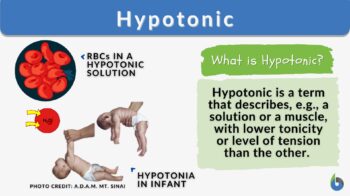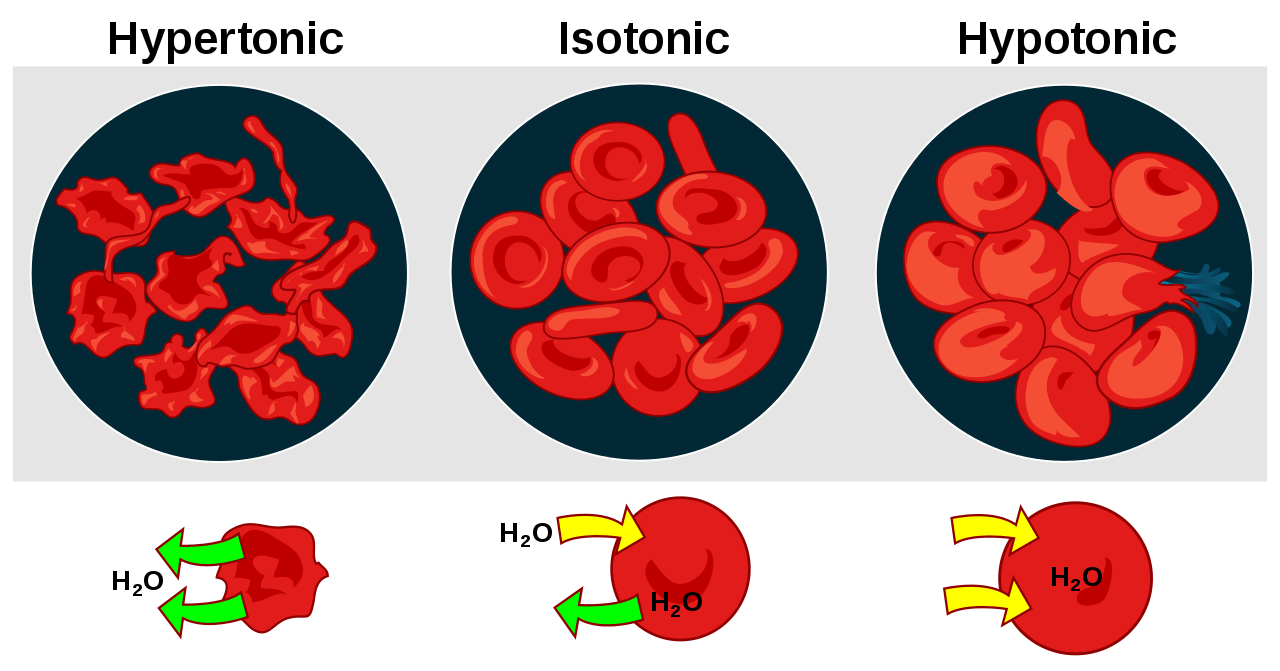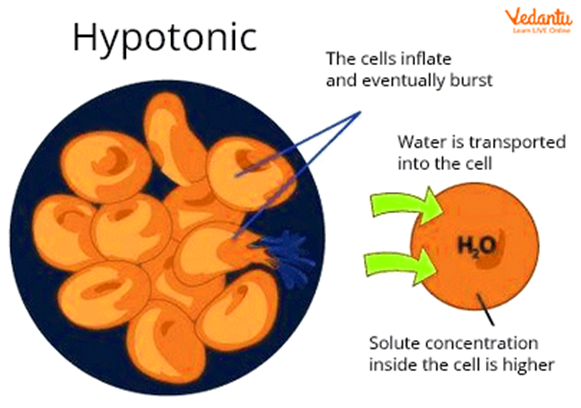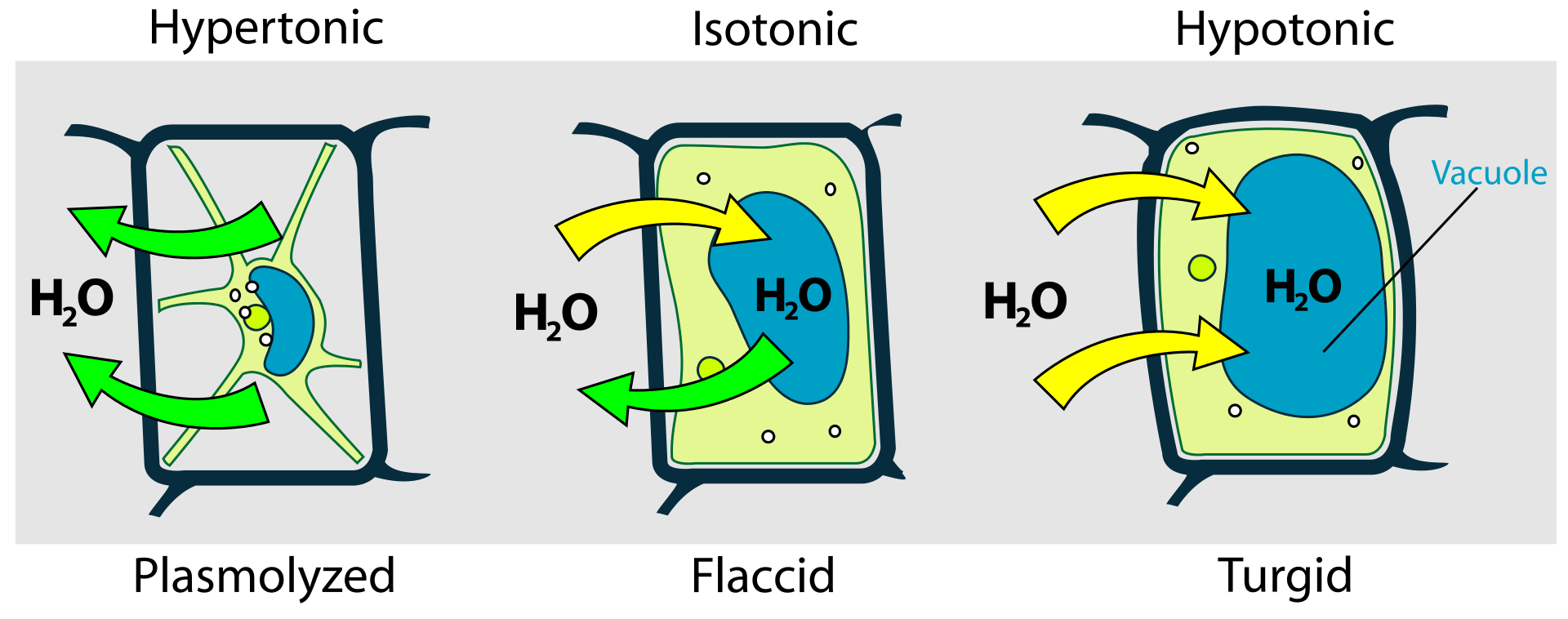
Hypotonic
adj., [haɪpəˈtɑnɪk]
Definition: Lower tension or solute concentration compared to a reference
Table of Contents
Hypotonic Definition
Hypotonic is a term used to describe an entity being in the state of hypotonicity. Hypotonicity refers to a state or condition characterized by having a lower degree of tone or tension. It is often used at the cellular level and at the tissue level. In particular, we say a solution surrounding a cell is hypotonic when it has a lower solute concentration. At the tissue level, a muscle is described as hypotonic when it has a lower degree of tone or tension while at rest.
Hypotonicity in Muscle Anatomy and Physiology
In human muscle anatomy, when we say “muscle tone”, we refer to how the muscle works while it is at rest. If you notice, a muscle would still have a certain degree of sustained contraction even when you do not voluntarily contract your muscle. When a muscle is hypotonic, it means there is not enough muscle activation going on while it is at rest. An example of such muscle is an infant with hypotonia characterized by having a C-shaped body and head lag (Figure 1).

It should not be confused, however, with flaccid muscle, which pertains to a muscle without a muscle tone or in a state of limpness. A hypotonic muscle still has some resting muscle activation but not as much activation as there is when a muscle is described as hypertonic. To better grasp this concept, watch the video below.
Hypotonic and hypertonic muscles:
Hypotonic Solution and the Cells
A hypotonic solution is a solution that has a lower concentration of solutes than the cell it is surrounding. A solute is a substance that is dissolved in a solution. Water is a solvent, which is the substance that dissolves the solute. This means that the water molecules in the solution will move into the cell across the cell membrane, causing the cell to swell.
The tonicity of a solution can be categorized into three distinct classes:
- Hypotonic solutions (with low solute concentration)
- Hypertonic solutions (with high solute concentration)
- Isotonic solutions (with the same solute concentration)
Solutions that have different tonicities will result in a net flow of water across the cell membrane driven by the concentration gradient. For example, a physiologic solution that is hypotonic to the blood serum would result in the net movement of water molecules towards the area with less water concentration (or higher solute concentration), which in this case is from the physiologic solution into the cell.

Biology definition:
A hypotonic is a term used to describe something that has a lesser degree of tone, tension, or tonicity. At the cellular level, it describes a solution with a comparatively lower solute concentration than that in another solution being compared. It may also indicate a lower osmotic pressure. At the tissue level, a muscle that is hypotonic is characterized by having a lesser degree of tone or tension while at rest.
Etymology: Ancient Greek “ὑπό” (hupó), meaning “under” and Ancient Greek “τονικός” (tonikós), from “τόνος” (tónos).
Compare isotonic, hypertonic
In the next sections, hypotonicity at the cellular level will be discussed in more detail, particularly, what are hypotonic solutions, their characteristics, and their effects.
Examples of Hypotonic Solutions and Their Cellular Effects
The following are examples of hypotonic solutions and their effects at the cellular level.
Paramecium
Paramecium is a single-celled organism with a contractile vacuole, which helps regulate its water balance (via osmoregulation). When a paramecium is placed in freshwater (a hypotonic solution), the water enters it through osmosis. The contractile vacuole becomes more active, pumping excess water out of the cell to prevent it from bursting due to the influx of water. This mechanism allows Paramecium to maintain its cellular integrity and prevent overexpansion.
Paramecia Contractile Vacuole:
In this scenario, the hypotonic solution (freshwater) has a lower solute concentration compared to the cytoplasm of the Paramecium cell, causing water to move into the cell and triggering the contractile vacuole’s response.
Plant Cell – Elodea Leaf Cell
Plant cells have a stiff cell wall that protects them from bursting when immersed in a hypotonic fluid. This is the basis for how plants maintain their rigidity and stand upright. For instance, water molecules move into the plant cell via osmosis when an Elodea leaf is immersed in a hypotonic fluid, such as distilled water. The central vacuole within the plant cell expands as it fills with water, causing the cell to become turgid and rigid. This increase in turgor pressure is responsible for maintaining the structural integrity of the plant, contributing to its overall stability.
Elodea cells in response to hypertonic and hypotonic solutions:
In this case, the hypotonic solution (distilled water) has a low solute concentration as compared to the cell’s contents, leading to the movement of water into the cell and the resulting turgor pressure.
Fungal Cell – Yeast Cell
Yeast cells are single-celled fungi that respond to changes in their environment, including tonicity. Water enters a yeast cell via osmosis when it is exposed to a hypotonic solution. Yeast cells possess a rigid cell wall made of chitin. In a hypotonic solution, the yeast cell’s volume increases, but the cell wall prevents it from bursting. The cell wall exerts outward pressure to counteract the inward osmotic pressure caused by water influx.
Yeast cells (Saccharomyces cerevisiae) under the microscope:
In this instance, the hypotonic solution’s lower solute concentration prompts water movement into the yeast cell, leading to volume expansion within the confines of the protective cell wall.
Animal Cells: Red Blood Cells
A hypotonic solution possesses a lower concentration of solute than that within the cell. Placing a red blood cell into a hypotonic solution leads to the movement of free water into the cell. This outcome results in an augmented intracellular volume characterized by a reduced concentration of intracellular solute particles. The solution itself ends up having a higher solute concentration. When observed under a microscope, the cell might appear swollen, and the plasma membrane may eventually rupture. This entire process is referred to as cytolysis. See Figure 2.
Osmosis represents a dynamic equilibrium, implying that free water molecules can temporarily move in various directions across the semipermeable membrane. However, the net movement of water molecules generally proceeds from an area of higher concentration to an area of lower concentration.
NOTE IT!
Hypotonic Solutions in Humans’ Daily Lives
- Contact lenses solutions, which are often formulated as hypotonic solutions are used in some types of contact lenses to help keep the lenses hydrated. The lenses are made of a material that allows water molecules to pass through, so the water molecules from the hypotonic solution will move into the lenses and keep them from drying out.
- Hypotonic sports drinks are specifically designed to facilitate rapid rehydration, making them ideal for various scenarios such as pre-hydration, shorter workouts, extended rides, and hot weather conditions. In a hypotonic drink, water concentration is higher outside the cell than inside the cell, causing water to move into the cell by osmosis. Upon consumption of a hypotonic drink, the solution undergoes osmotic movement across the gut walls, swiftly entering the blood vessels. This mechanism leads to rapid rehydration by facilitating the efficient absorption of the drink across the gut lining, thus, providing a quick source of electrolytes, minerals, and salts lost through sweat.
- Hypotonic sports drinks work also by incorporating carbohydrates, contributing to overall energy intake. This additional energy source can support physical performance during activities. They may contain fewer carbohydrates (<5%) and less salt than blood.
- Keep in mind that isotonic, hypertonic, and hypotonic sports drink solutions are different from one another and how they work. The best sports drink would, therefore, largely depend on the desired effects that one wants to achieve.
- » Isotonic sports drinks work more efficiently than hypotonic sports drinks because they are formulated to have a similar osmotic pressure as bodily fluids.
- » Hypertonic sports drinks work not for immediate hydration as replacing the fluids and electrolytes lost through sweat occur at a slower rate than hypotonic or isotonic drinks. They are, instead, used for post-workout recovery where extra caloric intake is desired along with some hydration.
Clinical Significance
Common hypotonic solutions include 0.45%, 0.225%, and 0.33% saline. They treat cellular dehydration in conditions like diabetic ketoacidosis. When administering Intravenous (IV) fluids, the focus is often on transferring water from intravascular to Red Blood Cells (RBCs). 0.45% saline is primarily for true dehydration, replenishing water content without needing extra electrolytes.
- Rehydration: Hypotonic solutions are employed to restore fluid balance and rehydrate patients. When individuals experience conditions such as dehydration, diabetic ketoacidosis (DKA), or hyperosmolar hyperglycemia, the use of hypotonic solutions helps replenish the body’s water content and improve overall hydration levels.
- Electrolyte Balance: Hypotonic solutions are often devoid of additional electrolytes, making them useful when the primary goal is rehydration without significantly altering the body fluids levels. This is particularly beneficial in cases where there’s a need to replenish water without causing electrolyte imbalances.
- Reducing Osmotic Pressure: By introducing a solution with lower solute concentrations, hypotonic solutions aid in lowering the osmotic pressure in a patient’s blood or extracellular fluid. This helps shift water into cells, facilitating cellular hydration and promoting the normalization of fluid levels.
- Preventing Osmotic Shifts: Hypertonic conditions, such as hypertonic dehydration, can lead to cells losing water and shrinking. Administering hypotonic solutions helps prevent this by supplying water to the cells and reversing the osmotic shifts.
- Clinical Procedures: Hypotonic solutions are also used as vehicle solutions for the dilution and administration of certain medications, particularly those that should be delivered in a more diluted form to minimize irritation or side effects.
- Lab Techniques: Hypotonic solutions are used in laboratory techniques, such as cell lysis, to break open cell membranes and release cellular contents for further analysis. The hypotonic solution disrupts the balance between the cell’s interior and the surrounding solution, leading to cell swelling and rupture.
- Monitoring Fluid Status: The administration of hypotonic solutions can help medical professionals monitor a patient’s response to treatment and assess changes in fluid status, such as improved hydration levels and reduction in symptoms associated with dehydration.
- Post-Surgical Care: Hypotonic solutions may be used postoperatively to ensure adequate fluid intake and support the recovery process. (Lopez & Hall, 2020)
Frequently Asked Questions on Hypertonic Solutions
What happens when a cell is placed in a hypotonic solution?
When a cell is placed in a hypotonic solution, the water molecules from the solution will move into the cell through the cell membrane. This is because the water molecules are always moving from an area of high concentration to an area of low concentration. The cell will keep swelling up until the solute concentration inside the cell is equal to the solute concentration outside the cell.
In a hypotonic solution, the concentration of solute is less, and the solvent concentration is comparatively elevated. When an animal cell is placed in a hypotonic solution, water ingress occurs through osmosis, leading to cellular expansion. The lack of a rigid cell wall in animal cells can result in their enlargement and eventual rupture. During exposure to a hypotonic solution, an animal cell undergoes a phenomenon termed hemolysis, characterized by cell rupture.

A plant cell responds differently as it absorbs water and becomes more rigid, resulting in increased turgor pressure. This is facilitated by the cell wall in plant cells, which exerts counteractive pressure on the cell membrane.

Is a hypotonic solution bad for cells?
A hypotonic solution can be “bad” for cells if it causes the cells to burst. However, if the hypotonic solution is not too strong, the cells can adjust through osmoregulatory mechanisms so as not to end up bursting.
Specific examples of solutions hypotonic to the cell?
Here are some examples of hypotonic solutions:
- Water
- Salt water with a lower salt concentration than the cell
- Sugar water with a lower sugar concentration than the cell
Take the Hypotonic – Biology Quiz!
References
- BYJU’S. (2023). Hypotonic Solution. Retrieved 23 August, 2023, from https://byjus.com/neet/hypotonic-solution/
- Lopez, M. J., & Hall, C. A. (2020). Physiology, osmosis.
- Toppr. (2023). Hypotonic Solution. Retrieved 23 August, 2023, from https://www.toppr.com/guides/chemistry/solutions/hypotonic-solution-definition-and-examples/
- Vedantu.com. (2023). Hypotonic Solution. Retrieved 23 August, 2023, from https://www.vedantu.com/biology/hypotonic-solution
- veloforte. (2023). Hypotonic vs Hypertonic vs Isotonic. Retrieved 23 August, 2023, from https://veloforte.com/blogs/fuel-better/difference-between-hypotonic-isotonic-and-hypertonic-sports-drinks
©BiologyOnline.com. Content provided and moderated by Biology Online Editors.



